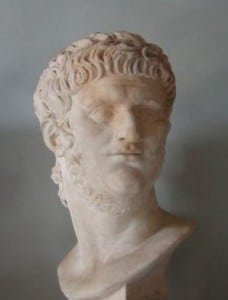- Most remembered as an evil man who sent many Christians to horrible deaths and sat idly by composing music while fire
 destroyed Rome.
destroyed Rome.
- Evidence that he was liked and respected by his army.
- First ten years of his reign ruled with the help of his two tutors, and ruled with good intentions (didn’t last long!)
- Loved extravagant fames and would rather compose music and poetry than take charge of affairs in army and provinces.
- Extremely conceited – people were even hired to applaud at his concerts.
- Arranged for the murder of his mother Agrippina by sending her on a decrepit ship that fell apart once it left the harbour. She swam and was rescued by a boat, but Nero had two naval officers murder her in her bed! He also had his step-brother poisoned.
- Great fire of Rome (68 A.D.) – Rumour was that Nero had the fire started to provide inspiration for a new ballad he was writing about the burning of Troy. To remove suspicion, he blamed the Christians (disliked anyway).
- Built the “Golden House” – a great palace and married a woman he later had murdered. He later had a man killed so he could marry his wife! He also stole a woman from another man (future emperor) but wound up kicking her to death.
- When rebellions broke out in Gaul and Spain, Nero responded by taking an artistic tour of Greece! The senate declared him a public enemy and ordered his death by the “flogging of rods.”
- He begged someone to stab him as he couldn’t do it himself until he heard sound of approaching Roman cavalry. He then stabbed himself in the throat and cried, “What an artist the world is losing!”
- After his death, bloody civil war raged for a year as five men fought for the throne.
